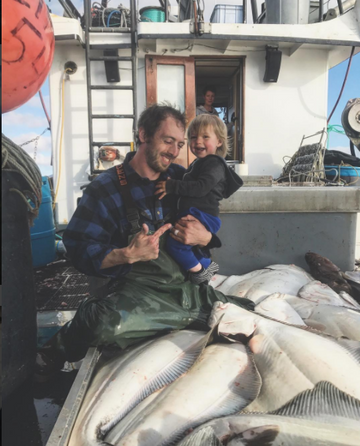
Seafood Producers Cooperative (SPC) is made up of families of fishermen. Fishing is not just a profession but a way of life. Many times this way of life is passed from father to son or daughter.
As an organization that has had hundreds of fishermen/owners over the course of over 75 years, we’ve watched fishing livelihoods handed down through generations of fishermen. Fathers have entrusted their fishing traditions to younger generations with whom they share their knowledge, rituals and wisdom.

With some Alaskan halibut.
One fishing family that has been essential to the history of Seafood Producers Cooperative (SPC) is the Andersen family. Toivo Andersen joined our co-op in 1961. His son Alan joined the co-op in 1974 and Alan’s son Jaycen became a co-op owner in 2011. Now Jaycen brings Odin, another fishing Andersen, out fishing to learn the craft as well.
The Andersen family has kept a proud tradition with SPC. As Toivo said, “The young fellows, if they see the pride we got in the Co-op […] and when they work with it, they got everything to gain.”
Pioneering the Fairweather Grounds: Trolling for King Salmon
Toivo was one of the early pioneers who first fished the Fairweather Grounds, some of the most productive king salmon fishing grounds on the planet. In the early 1950s, Toivo explored the waters about 35 to 50 miles off Cape Fairweather. Although early fishermen lacked any sure method of locating and holding the banks where fish feed during those pre-electronic days except by compass, lead line, and their own good sea sense, in the years following many others followed these fishing pioneers out to the Fairweather Grounds.
The Fairweather name is a bit of a misnomer. “Bad weather prevented completion of the voyage” is how many of the seafaring tales of those early pioneers ended. But, “[t]he Fairweather Grounds has its devotees, people who almost refuse to fish elsewhere even when they know they might find better fishing. They are known as “Fairweather fishermen,” a “slightly contradictory term since they prefer operating in waters known for rough conditions. It is assumed that anyone qualified for the title is a really tough fisherman, one who doesn’t mind getting his ears pinned back by the frequent gales.”
Toivo and the other early pioneers of the Fairweather Grounds used compasses and fathometers to find their fishing spots. They had radio direction finders that enabled them to take bearings on each other but no land stations. If their fathometers indicated they were in fifty fathoms, the edge of the shallow grounds, they would drop anchor. When they caught salmon in what has been known as the “fleet corner” of the East Bank, one of them let go a halibut anchor with buoy line and flagpole attached in order to mark the spot. The fishing in the Fairweather Grounds could be spectacular and still is. Andersen claimed his best day was 282 kings, a lot of fish, especially considering that in those days a king would average 19 pounds or so.
After their first venture, Toivo and the early pioneers were not able to return for a couple more years–the risks were too great–but when they did, they brought a new innovation that had been a “secret weapon” during the final days of World War II, the Loran–Long Range Navigation. The Loran required skill and lots of tinkering, but gave the fishermen the ability to more accurately measure where they were and where the fish lay feeding. With that innovation, boats began following Toivo Andersen and the other early Fairweather pioneers out to the Fairweather Grounds, which became a place known for remoteness, treacherous weather, and splendid fishing.
The Andersen family fishing tradition continued when Toivo’s son Alan became one of the first fishermen from Alaska on the Co-op’s Board of Directors in the late 1970s. At that time, most Co-op owners fished up and down the West Coast from northern California up to Alaska, but tended to winter in Washington state. Indeed the Co-op was formed in Ballard, a maritime district in Seattle known for its fishing history. Alan was an early and strong advocate for the the Co-op to build a plant in Sitka, home of some of the most productive salmon trolling grounds on the Pacific coast. It took a lot of courage to push hard for the plant, knowing the huge financial sacrifice fishermen/owners would need to make in order to build the plant. It turned out that it was the right decision and the plant is still the pride of the Co-op.
Alan’s son Jaycen now sits on the Seafood Producers Cooperative (SPC) Board of Directors knowing the weight that his father and grandfather pulled for the Co-op. Bringing little Odin, another fishing Andersen, out on the water with him makes clear that future generations will be part of the fishing tradition. As Jaycen notes in this video, "Being part of the SPC, it's a family [...] I've known those guys--the [fish] graders and the ice men since I was my son's age."

Little O and the Cinnabar on the Alaska coast.



